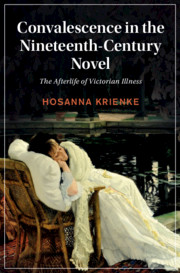Book contents
- Convalescence in the Nineteenth-Century Novel
- Cambridge Studies in Nineteenth-Century Literature and Culture
- Convalescence in the Nineteenth-Century Novel
- Copyright page
- Dedication
- Contents
- Acknowledgments
- Introduction Convalescent Time
- Chapter 1 Convalescence and the Working Class
- Chapter 2 Spiritual Convalescence
- Chapter 3 Novel Reading as Convalescence
- Chapter 4 Convalescence and Mental Illness
- Chapter 5 Imperial Convalescence
- Conclusion Convalescent Futures
- Notes
- Bibliography
- Index
- Cambridge Studies in Nineteenth-Century Literature and Culture
Introduction - Convalescent Time
Caregiving and the Strain of Modern Life
Published online by Cambridge University Press: 24 May 2021
- Convalescence in the Nineteenth-Century Novel
- Cambridge Studies in Nineteenth-Century Literature and Culture
- Convalescence in the Nineteenth-Century Novel
- Copyright page
- Dedication
- Contents
- Acknowledgments
- Introduction Convalescent Time
- Chapter 1 Convalescence and the Working Class
- Chapter 2 Spiritual Convalescence
- Chapter 3 Novel Reading as Convalescence
- Chapter 4 Convalescence and Mental Illness
- Chapter 5 Imperial Convalescence
- Conclusion Convalescent Futures
- Notes
- Bibliography
- Index
- Cambridge Studies in Nineteenth-Century Literature and Culture
Summary
Today, we wish each other a “speedy recovery” when we fall ill; Victorians, by contrast, aspired to a delightfully slow, meandering recuperation. In fact, the slow time of convalescent care – characterized by uncertain progress, ambiguous outcomes, and an emphasis on daily pleasures – was deemed crucial to its therapeutic value. In the face of the seemingly accelerated pace of modern life, many nineteenth-century thinkers turned to traditional, open-ended practices of convalescent care as a promising way to ameliorate the harms of the harried modern age, particularly for working-class and impoverished sufferers. This book tells the story of how a culture-wide consensus surrounding the benefits of convalescence helped to rationalize new practices and institutions in the long nineteenth century: philanthropic homes specializing in relaxation, moral transformations that took place in fits and starts, extended aftercare for asylum inmates, and even a method of aimless novel-reading for overworked professionals. As I will show, many novels accumulate convalescent characters in order to initiate readers into a beneficial experience of tracking slow, fitful progress. Indeed, the novels profiled here deliberately harness what I call “convalescent time” in order to train readers in an ethical reading posture in which the slowly emerging and contingent meanings of the unfolding plot could be valued over and above the novel’s own chosen resolution.
- Type
- Chapter
- Information
- Convalescence in the Nineteenth-Century NovelThe Afterlife of Victorian Illness, pp. 1 - 22Publisher: Cambridge University PressPrint publication year: 2021

